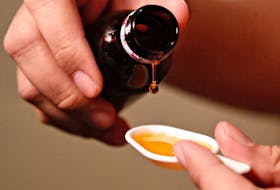About one-quarter of communities in Newfoundland and Labrador have excess levels of trihalomethanes (THMs) in their drinking water.
These communities do not meet Health Canada standards.
THMs, along with haloacetic acids, are chemical compounds formed when chlorine reacts with organic material commonly found in surface water.

While it takes long-term exposure to disinfection byproducts in drinking water to cause serious health issues, Health Canada has set standards for safe consumption. The communities not meeting the minimum — the largest of which is Pasadena (outside the St. John's area) — have excessive numbers of these concerning contaminants, some as high as 2-3 times the acceptable levels.
RELATED
EDITORIAL: Clean drinking water is vital
'Miawpukek First Nation drinking water advisory lifted after nearly 4 years'
'Corner Brook’s water described as some of best in Atlantic Canada'
Disinfecting water supplies is crucial for public health, but it comes with this side-effect communities need to keep an eye on for the long-term.
The spectre of excessive levels of THMs in Pasadena’s drinking water recently raised its head. The latest testing shows the town’s water supply has a moderately high level.
While more research is required in the field, Health Canada states some THMs are considered to possibly be carcinogenic and some could cause adverse reproductive effects.
While that sounds quite serious, the prevailing thought on the subject is that the potential risks associated with excessive THM levels involve long-term exposure and pale in comparison to the more immediate effects of not disinfecting drinking water. Disinfecting water kills off nasty disease-causing bacteria, such as E. coli, salmonella, giardia and campylobacter, which can cause serious digestive illnesses.
There are other means of disinfecting water, but chlorine remains the most common, especially in Newfoundland and Labrador.
The communities are largely on their own in finding solutions that would improve their water and reduce the level of THMs.
Pasadena Mayor Gary Bishop, whose council discussed THM levels at a public meeting in October, said as far as council knows there are no risks in drinking the water, but the town still wants to see what it can do to bring the levels back down to the accepted standard.
“It’s not a major concern, but it is something we have to have addressed, yes,” said Bishop.
The fact no health authorities are applying any pressure on the town to take action gives him assurance there is no urgency yet.
“Even though they have a standard here, nobody really enforces it,” said Bishop. “Nobody from Health Canada or the province comes in to us and tells us to do this or that. They take the tests, give you the results and then you do as you see fit.”
Boiling won’t work
Many towns across Newfoundland and Labrador are subject to boil orders, but that is not how THMs are removed from water supplies.
According to Health Canada and the province, the best way to reduce THMs is to reduce the amount of organics getting through filtration systems prior to chlorination.
There are success stories about overcoming THM issues in western Newfoundland.
Corner Brook used to have excessive levels, but they have been brought under control by the city’s new, multi-million water treatment plant.
The Town of St. George’s has nearly eliminated THMs with its new wellfield system. In its backup water supply, however, there are more than four times the acceptable level.
Bishop is not sure what Pasadena will be able to do.
“Our system is one of the premiere systems on the west coast,” he said.
The town currently has a triple filter system in place, the final step of which is an ultraviolet light.
Bishop says this is an issue Pasadena will continue to pursue.
“It’s a health issue we have to deal with," he said.
Reviewing options
Brian Hudson, Pasadena’s chief administrative officer, confirmed the town is engaging a consulting firm that specializes in water resources and distribution systems to review the options available to the town. With finding an alternative water source not among those options, Hudson said removing organics prior to the chlorination process will likely be the focus.
With the UV light stage considered one of the best ways to do that, Hudson said coming up with another treatment process between the UV light and chlorination stages may be what’s needed.
Another option could be storage tank aeration.
The town will also look at doing more monitoring at different parts of the system to try to pinpoint where its focus needs to be.
Having this issue is frustrating for the town because, when Pasadena installed its current system around a dozen years ago, the acceptable Health Canada levels were twice what they are now.
In recent years, the Town of Pasadena has also pushed the intake pipe at its water supply at Blue Gulch Pond further out into the pond and up off the bottom so there is less organic material making its way towards the filtration and chlorination stage.
“If the investigation comes back that we have to invest in capital infrastructure within the plant to put in an additional process, it will require significant capital investment,” he said.
What people can do at home
It is possible for individual households and businesses to install filters that can remove some THMs. According to the provincial government, only properly used treatment units with “NSF Standard 53” on the label are effective in removing THMs at the tap.
Hudson said the town doesn’t want to leave the onus on residents to take measures to improve their water.
“Some people use filters, and some perhaps (are reducing THMs in their tap water) unknowingly, but we are looking to ensure THM levels are reduced on the full distribution model so residents don’t have to worry about that,” he said.
Worse offenders
Pasadena is far from alone in having a THM issue.
Between Gros Morne National Park and the Port au Port Peninsula, the highest THM levels recorded in the most recent round of provincial monitoring were found in St. Paul’s.
The levels were a little more than three times the accepted standard.
Wayne Bennett recently retired from a 22-year career as the maintenance employee responsible for the water quality in St. Paul’s. Although the town’s levels are still high, they used to be four times over the limit.
Bennett said he and the town worked hard to monitor the water and to keep the chlorine use to a minimum in order to bring them down.
“Other than taking some expensive drastic measures, we can’t do much more than that,” said Bennett.
He believes this is an issue that the federal and provincial governments should be doing more to help out with.
“It’s the only way the town can afford to do anything about this really,” he said of government assistance. “The town has been interested in trying to bring it down to a reasonable level, but they’ve done all they can afford to do.”

Memorial University professor dedicating career to helping communities lower THM levels
While disinfection byproducts such as trihalomethanes (THMs) continue to be an issue for many Newfoundland and Labrador communities, Tahir Husain has been quietly trying to help reduce them.
The native of India, who has worked at the King Fahd University in Saudi Arabia and as a visiting scientist at the Harvard School of Public Health since earning his PhD in 1979, has been a civil engineering professor at Memorial University of Newfoundland since 1995.
He also spent three years as associate dean of research at Memorial.
After spending the first half of his career in St. John’s working on risk assessment, Husain has spent the past decade or so trying to develop new technologies to address the issue of trihalomethanes (THMs) and haloacetic acids (HAAs) in public drinking water systems.
Around one-quarter of Newfoundland and Labrador’s small communities have THM levels that exceed Health Canada’s standards, while around one-third have excessive levels of HAAs.
While exposure to borderline levels may not be much of a concern, Husain said communities should be addressing their water quality when the levels rise above the set standards.
“Once the level is 2-3 times (higher than Health Canada standards), and people have been drinking that same water for a long period of time — like 10, 15 or 20 years, then one should get concerned about that,” Prof. Tahir Husain
Long-term exposure to high levels of THMs and HAAs, which are byproducts created when chlorine reacts with organic material in the water, are linked to cancer and other health issues, including reproductive problems.
More stringent in the U.S.
South of the border, the standards set by the United States Environmental Protection Agency are actually lower than Canada’s. While Canada’s acceptable level of THMs is set at 100 parts per billion, the American standard is 80. For HAAs, the agency’s limit of 60 parts per billion is also 20 parts per billion lower than Health Canada’s.
Husain believes Health Canada is striving to lower its levels closer to those set by the United States. That will make it even harder for smaller communities, which Husain said have less resources to combat disinfection byproduct issues than urban centres do, to address them.
While he said the provincial government has been doing a good job monitoring water quality for THMs and HAAs, doing something to effectively lower the levels is harder to accomplish.
He said towns can’t just go buy a filtration system and assume it will work for them. Every water supply has its own characteristics that must be studied for years before a decision on what will work best can be made.
There are two kinds of natural organic matter found in water sources. Some are hydrophilic or easily dissolved in water, while some are hydrophobic and won’t dissolve in water, and towns must first determine what kind they have in their water.
Husain has been working on new technologies that will remove both kinds before water is chlorinated. Much of the hydrophilic material can be removed through carbon filtration. Hydrophobic materials can be removed by a process of coagulation.
These are two simple technologies that will not cost much, he said.
Real-life application
Husain and his research team at Memorial University have been working with some small communities in eastern Newfoundland that have concerning levels of disinfection byproducts in their water.
The carbon filtration model Husain and his assistants have been developing actually uses ash from Corner Brook Pulp and Paper’s operations because that material has a high concentration of carbon. He figures the ash produced by the paper mill could supply enough carbon for filtration systems in 25-30 small communities.
Husain wants to bring the work out of the laboratory and into practice in a municipal setting. That will require more research funding to develop the technology on a bigger scale and more capital works funding for the towns that want to install such systems.
The end result, he said, will be nearly negligible levels of THMs and HAAs and a bonus benefit of towns requiring less chlorine to disinfect their drinking water.
“It is something I’ve been thinking about for a long time because these communities cannot afford very expensive technology,” he said.
Another limitation for small communities, he said, is they don’t have a skilled operator to operate the system.
These are the two factors he considered for beginning to develop this kind of technology.
“I feel it has moved to a level where it needs to move to a proof of the concept in the field.”

What’s the deal with THMs?
- According to Health Canada, public drinking water supplies should have no more than 100 micrograms per litre (parts per billion) of trihalomethanes.
- Trihalomethanes are a group of compounds that can form when the chlorine used to disinfect drinking water reacts with naturally occurring organic matter (e.g., decaying leaves and vegetation).
- The health risks from disinfection byproducts, including trihalomethanes, are much less than the risks from consuming water that has not been disinfected.
- The use of chlorine in the treatment of drinking water has virtually eliminated waterborne diseases, because chlorine can kill or inactivate most micro-organisms commonly found in water.
- The majority of drinking water treatment plants in Canada use some form of chlorine to disinfect drinking water, to treat the water directly in the treatment plant and/or to maintain a chlorine residual in the distribution system to prevent bacterial regrowth.
- Utilities should make every effort to maintain concentrations of all disinfection byproducts as low as reasonably achievable without compromising the effectiveness of disinfection.
- The trihalomethanes most commonly found in drinking water are chloroform, bromodichloromethane (BDCM), dibromochloromethane (DBCM) and bromoform.
- Chloroform is considered to be a possible carcinogen in humans, based on limited evidence in experimental animals, and inadequate evidence in humans.
- Exposure to BDCM at levels higher than the guideline value has also been linked to a possible increase in reproductive effects (increased risk for spontaneous abortion or stillbirth) above what can normally be expected. Further studies are required to confirm these effects.
Source: Health Canada
Communities to watch
Some communities in western Newfoundland that have THM levels exceeding Health Canada’s standard (as of Sept. 12, 2018) and which don’t provide potable water dispensing units as an alternative:
St. Paul’s
Source: Two Mile Pond
Latest average reading: 310 micrograms per litre
Lourdes
Supply: Victor’s Brook
Latest average reading: 223.25 micrograms per litre
Pasadena
Supply: Blue Gulch Pond
Latest average reading: 175 micrograms per litre
McIvers
Supply: McIvers Brook
Latest average reading: 172 micrograms per litre
Steady Brook
Supply: Wellfield and Steady Brook
Latest average reading: 158.5 micrograms per litre
Rocky Harbour
Supply: Gull Pond
Latest average reading: 152.25 micrograms per litre
Gillams
Supply: Meaters Pond
Latest average reading: 112 micrograms per litre
Meadows
Supply: Meaters Pond
Latest average reading: 101.25 micrograms per litre
Source: Department of Municipal Affairs and Environment
Some of the highest levels found anywhere in Newfoundland and Labrador:
- Keels: 785 micrograms
- Point May: 557.5
- McCallum: 543
- Salvage: 497.5
- La Poile: 440
- Seldom/Little Seldom: 420
- Tilting: 415
- Burlington: 386.25
- Burgeo: 345 micrograms
Source: Department of Municipal Affairs and Environment
Weblinks
Latest trihalomethane (THM) summary data for all communities in Newfoundland and Labrador
Latest haloacetic acid (HAA) summary data for all communities in Newfoundland and Labrador
More information on health risks associated with THMs and HAAs can be found in the following documents:
- Guidelines for Canadian Drinking Water Quality: Guideline Technical Document – Haloacetic Acids
- Guidelines for Canadian Drinking Water Quality: Guideline Technical Document – Trihalomethanes
*** Story edited Nov. 21 to change reference of "largest community in province" to "largest community outside the St. John's area."









